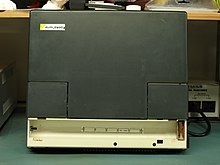Dulmont Magnum
[12][13][9]: 285 Development dragged on and the project was in danger of folding due to Dulmison's limited financial resources but was revitalised when Mackness secured a A$800,000 federal government grant.
[11] The Magnum was to have been enabled by a custom power management integrated circuit that was to be developed in the VLSI and Systems Technology Laboratory at the University of New South Wales (UNSW) over 4 months in early 1982 by Graham Hellestrand.
The project's engineering manager and contracted Barry Wilkinson to design the hardware based on discrete components as there were doubts about the custom chip.
The Magnum was launched publicly at the 10th Australian Computer Conference on same day that Australia won the America's Cup in September 1983.
It also featured dual 128K ROM cartridge slots, which could be used for optional software including BASIC or assembler programming support, as well as serial and parallel modem and printer ports.
Earlier versions were able to be upgraded to the larger displays, and a dual 5.25" floppy drive and memory expansion box provided access to up to 256KB of dynamic RAM.
[6] A second disadvantage of the Magnum was the lack of integral permanent storage other than the ROM/EPROM that was available through the module cartridge slots,[clarification needed] or the separate expansion box.





